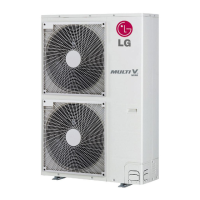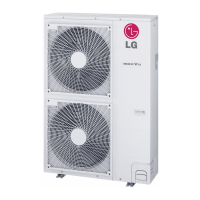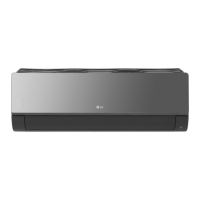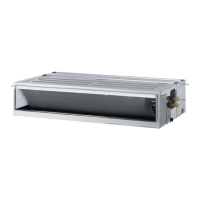When none are available, follow the instructions below.
- Do not connect wiring of different thicknesses to the power terminal
block. (Slack in the power wiring may cause abnormal heat.)
- When connecting cable which is the same thickness, do as shown in
the figure below.
- For wiring, use the designated power cable and connect firmly, then
secure to prevent outside pressure being exerted on the terminal
block.
- Use an appropriate screwdriver for tightening the terinal screws.
A screwdriver with a small head will strip the head and make proper
tighterning impossible.
- Over-tightening the terminal screws may break them.
NOTE
!
• The figures are based on assumed length of parallel cabling up
to 100 m (328.1 ft). For length in excess of 100 m (328.1 ft) the
figures will have to be recalculated in direct proportion to the ad-
ditional length of line involved.
• If the power supply waveform continues to exhibit some distor-
tion the recommended spacing in the table should be increased.
- If the lines are laid inside conduits then the following point
must also be taken into account when grouping various lines
together for introduction into the conduits
- Power lines(including power supply to air conditioner) and sig-
nal lines must not be laid inside the same
- In the same way, when grouping the lines power and signal
lines should not be bunched together.
Current capacity of power cable Spacing
100 V or more
10 A 300 mm (11-13/16 inch)
50 A 500 mm (19-11/16 inch)
100 A 1,000 mm (39-3/8 inch)
Exceed 100 A 1,500 mm (59-1/16 inch)
CAUTION
If apparatus is not properly earthed then there is always a risk of
electric shocks, the earthing of the apparatus must be carried out by
a qualified person.
!
Wiring of Main Power Supply and Equipment Capacity
- Use a separate power supply for the Outdoor Unit and Indoor Unit.
- Bear in mind ambient conditions (ambient temperature,direct sun-
light, rain water,etc.) when proceeding with the wiring and connec-
tions.
- The wire size is the minimum value for metal conduit wiring. The
power cord size should be 1 rank thicker taking into account the line
voltage drops. Make sure the power-supply voltage does not drop
more than 10 %.
- Specific wiring requirements should adhere to the wiring regulations
of the region.
- Power supply cords of parts of appliances for outdoor use should not
be lighter than polychloroprene sheathed flexible cord.
- Don't install an individual switch or electrical outlet to disconnect
each of indoor unit separately from the power supply.
CAUTION
• Some installation site may require attachment of an earth leakage
breaker. If no earth leakage breaker is installed, it may cause an
electric shock.
• Do not use anything other than breaker and fuse with correct ca-
pacity. Using fuse and wire or copper wire with too large capacity
may cause a malfunction of unit or fire.
• When the 400 volt power supply is applied to "N" phase by mistake,
replace inverter PCB and transformer in control box.
!
WARNING
• Follow ordinance of your governmental organization for techni-
cal standard related to electrical equipment, wiring regulations
and guidance of each electric power company.
• Make sure to use specified wires for connections so that no ex-
ternal force is imparted to terminal connections. If connections
are not fixed firmly, it may cause heating or fire.
• Make sure to use the appropriate type of overcurrent protection
switch. Note that generated overcurrent may include some
amount of direct current.
!
Communication and Power Lines
Communication cable
- Types : shielding wire
- Use wires of size : over 1.25 mm
2
(0.002 in
2
)
- Maximum allowable temperature: 60 °C (140 °F)
- Maximum allowable line length: under 300 m (984.3 ft)
Remote control cable
- Types : 3-core cable
Simple central control cable
- Types : 4-core cable (Shielding wire)
- Use wires of size : over 0.75 mm
2
(0.001 in
2
)
Separation of communication and power lines
- If communication and power lines are run alongside each other then
there is a strong likelihood of operational faults developing due to in-
terference in the signal wiring caused by electrostatic and electro-
magnetic coupling.
The tables below indicates our recommendation as to appropriate
spacing of communication and power lines where these are to be run
side by side

